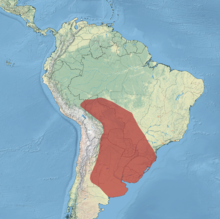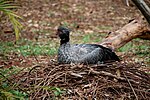| Southern screamer | |
|---|---|

| |
| in the Pantanal, Brazil | |
| Conservation status | |
 Least Concern (IUCN 3.1) | |
| Scientific classification | |
| Domain: | Eukaryota |
| Kingdom: | Animalia |
| Phylum: | Chordata |
| Class: | Aves |
| Order: | Anseriformes |
| Family: | Anhimidae |
| Genus: | Chauna |
| Species: | C. torquata |
| Binomial name | |
| Chauna torquata (Oken, 1816) | |

| |
| Distribution map | |
The southern screamer (Chauna torquata) is a species of bird in family Anhimidae of the waterfowl order Anseriformes. It is found in Argentina, Bolivia, Brazil, Paraguay, Peru, and Uruguay.
Taxonomy and systematics
The southern screamer shares genus Chauna with the northern screamer (C. chavaria). One other species, the horned screamer (Anhima cornuta) is also in family Anhimidae. The southern screamer is monotypic.
Description
The southern screamer is one of the largest birds of southern South America at 83 to 90 cm (33 to 35 in) long and weighing about 4.4 kg (9.7 lb). Their flat wing measures 50 to 57 cm (20 to 22 in), their tail 22 to 26 cm (8.7 to 10.2 in), and their culmen 4.0 to 5.4 cm (1.6 to 2.1 in). They are stout bodied with a disproportionately small head and a "chicken-like" grayish brown bill. The sexes have the same plumage. Their head and upperparts are gray with a velvety black "collar" around the base of the neck. Their wings and tail are dusky and the wing has two sharp spurs at its manus. The front of their neck, their breast, and their sides are pale gray faintly mottled and streaked with white. Their belly is unmarked pale gray or white. Their legs and feet are rosy.
Distribution and habitat
The southern screamer is found from the eastern half of Bolivia south into Argentina as far as Buenos Aires Province and east through Paraguay into southwestern Brazil and Uruguay. It has also been documented as a vagrant in southeastern Peru. It inhabits tropical and subtropical wetlands including lakes, marshes, and flooded meadows with scattered trees.
Behavior
Movement
The southern screamer is generally considered to be non-migratory. However, seasonal changes in the numbers present in coastal and inland parts of Brazil's Rio Grande do Sul suggest local movements between them.
Locomotion
The southern screamer is a good swimmer but prefers to move on the ground. It is an excellent flier and soarer.
Feeding
The southern screamer feeds on the leaves, stems, and seeds of aquatic plants and also on some crops. They usually graze like geese but have been seen digging for food. Flocks of up to about 100 forage together in the non-breeding season.
Breeding
The southern screamer forms long-term pair bonds that in some cases last for life. Males and females court with mutual preening and duet calling. They build a large nest of sticks and reeds near shallow water and often nest in about the same location for several years. The typical clutch size is three to five eggs but can be up to seven; eggs are laid in October and November. Both parents incubate the eggs and care for the young. The incubation period is 43 to 46 days; fledging occurs eight to ten weeks after hatch and the young are independent after about 12 weeks.
|
Songs and calls Listen to southern screamer on xeno-canto |
Vocalization
The southern screamer's "loud, unmelodious, double-noted trumpet call" has been further described as "a low, throaty, almost barking, brief oh-WOOOW which also sounds sometimes as be-SERK." Female's calls are somewhat weaker and higher pitched than males'. Screamers call both in flight and when perched, and the call can be heard of up to 3 km (2 mi).
Domestication
Southern screamers are sometimes domesticated and are very good guard animals because of their loud, far carrying, call.
Status
The IUCN has assessed the southern screamer as being of Least Concern. It has a very large range, and though its population size is unknown it is believed to be stable. No immediate threats have been identified. Draining of wetlands and persecution by farmers are potential threats but "the species seems able to compensate fairly well".
Gallery
-
 On a nest at Iguazu Bird Park, Brazil
On a nest at Iguazu Bird Park, Brazil
-
 Sitting on two eggs.
Sitting on two eggs.
-
 Family in Rio Grande do Sul, Brazil
Family in Rio Grande do Sul, Brazil
-
Chicks
-
 Head
Head
-
 At Artis Zoo, Netherlands
At Artis Zoo, Netherlands
-
In flight, the Pantanal, Brazil
References
- ^ BirdLife International (2016). "Southern Screamer Chauna torquata". IUCN Red List of Threatened Species. 2016: e.T22679729A92826769. doi:10.2305/IUCN.UK.2016-3.RLTS.T22679729A92826769.en. Retrieved 30 September 2022.
- ^ Gill, F.; Donsker, D.; Rasmussen, P., eds. (August 2022). "Screamers, ducks, geese, swans". IOC World Bird List. v 12.2. Retrieved August 9, 2022.
- Remsen, J. V., Jr., J. I. Areta, E. Bonaccorso, S. Claramunt, A. Jaramillo, D. F. Lane, J. F. Pacheco, M. B. Robbins, F. G. Stiles, and K. J. Zimmer. Version 24 July 2022. Species Lists of Birds for South American Countries and Territories. https://www.museum.lsu.edu/~Remsen/SACCCountryLists.htm retrieved July 24, 2022
- ^ Brady, S. (2020). Southern Screamer (Chauna torquata), version 1.0. In Birds of the World (T. S. Schulenberg, Editor). Cornell Lab of Ornithology, Ithaca, NY, USA. https://doi.org/10.2173/bow.souscr1.01 retrieved September 30, 2022
